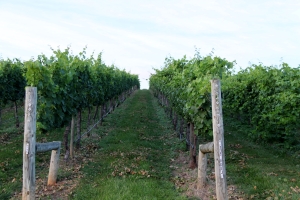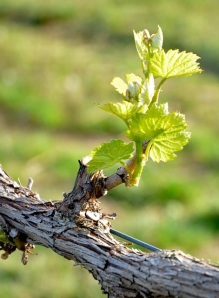Keswick Vineyards, and the year thus far.
I have been reminded by my wife that my blogging career has taken a serious turn for the worse of late, and that I have shirked my duties. My apologies. It is hard to believe that 2012 is almost half over and that we are around 60 days from starting the 2012 harvest. Where has the time gone?
After the challenging 2011 harvest, we duly set about pruning the vineyard after Christmas with the intention of building the vineyard back slowly. This was done by reducing the number of buds on the vine, and also by a new pruning method of cane pruning. In the past we have spur pruned, whereby 3-4 spurs [each having 2-3 buds] are left on each of the cordons. Cane pruning means laying down a one year old shoot, leaving 6-8 nodes, simply establishing a new cordon each and every year. The primary reason for cane pruning, was to allow us to remove cordons and shoots that showed incidences of phomopsis. Phomopsis Viticola overwinters as Pycnidia on infected wood between one and three years old. When the Pycnidia are wet, the exude spores that are splashed onto developing shoots. These spores then germinate in warm temperatures, and under conditions of high humidity, infection can take place within a few hours. This is one of the challenges facing growers as fruit and the rachis [main axis of the inflorescence of Vitis vinifera] can become infected throughout during the growing season. When fruit starts to ripen in the latter stages of the growing season, the pathogen becomes active leading to fruit rot. Symptoms include browning and shriveling, almost resembling black rot. Pruning is done during winter while the vineyard is in a dormancy phase.
This year however, mother nature thought that 70 degree days were called for, great for pruning in shorts, not so great when it leads to an early bud break. We started noticing some cuts starting to bleed [due to osmotic forces pushing liquid from the roots], which is one of the early signs that vines are starting to break dormancy. Our vineyard duly had bud break March 22nd, while we were still frantically trying to complete the pruning of the vineyard. One of the issues of an early bud break is the susceptibility of the vines to spring frosts, and true to form, Mother Nature duly obliged and threw seven days at us where temperatures were below freezing.
We experienced a radiation freeze, marked by beautifully clear skies and no wind. Under these conditions, air stratifies near the ground and radiant heat loss occurs from the ground and vine tissues. 4 am is such an un-appreciated time of morning, well when you are forced to get up, you just convince yourself it is a great time. Wind machines were duly run, frost dragons were making their way through the vineyards and raging fires were tended to, all trying to raise the ambient temperature to protect our vineyard. We did lose some fruit, estimated at about 5% in the Chardonnay but for us that is a minor miracle. Flowering and fruit set duly occurred with no major issues, and I am happy to report that we have a full crop thus far.
 I touched on the fact that we have been experimenting the slightly different training techniques and since last year gave us no good indication of how effective our new systems are, we are once again trying to grow in the fruit in a slightly different way. Conventionally vines are trained vertically in a series of catch wires, aptly named the Vertical Shoot Position [V.S.P]. we however are experimenting with a split system or divided canopy, whereby only 50% of the shoots are trained vertically while the rest of the canopy is allowed to hang down. There are a couple of thought processes with regards to this system. Our primary soil is clay, which leads to pretty serious vegetative growth. In our climate marked by warm temperatures and high humidity, we have to be mindful of diseases. By splitting the canopy we feel we can create and an environment that allows great air movement through the canopy, better sunlight exposure which ultimately suppresses the disease pressure and more importantly riper fruit with better flavors.
I touched on the fact that we have been experimenting the slightly different training techniques and since last year gave us no good indication of how effective our new systems are, we are once again trying to grow in the fruit in a slightly different way. Conventionally vines are trained vertically in a series of catch wires, aptly named the Vertical Shoot Position [V.S.P]. we however are experimenting with a split system or divided canopy, whereby only 50% of the shoots are trained vertically while the rest of the canopy is allowed to hang down. There are a couple of thought processes with regards to this system. Our primary soil is clay, which leads to pretty serious vegetative growth. In our climate marked by warm temperatures and high humidity, we have to be mindful of diseases. By splitting the canopy we feel we can create and an environment that allows great air movement through the canopy, better sunlight exposure which ultimately suppresses the disease pressure and more importantly riper fruit with better flavors.
 Our best fruit, which grow on some of our poorest soils are still trained vertically, where vigor and retention of water does not pose any serious threat to the quality of the vines and thus the fruit. At this point in the vineyard we are trying to ensure the vines and vineyard are in balance, ensuring that we leave the optimum amount of fruit that will be harvested at ideal picking parameters. We are currently pulling some leaves on the East side of the vines, exposing the fruit on the cooler side as sunburn is a serious threat with temperatures forecasted to reach the 100 degree mark in the next few days. A lot of people ask us about the attitude towards diseases and what we do to combat it. The honest answer is that we have a detailed spray schedule worked out, whereby we spray what is needed, when is needed and most importantly how little is needed. It would be fantastic to talk about organic grape growing, probably even more marketable would the term byoynamically farmed. The truth of the matter s that Virginia's climate [in my opinion] does not allow the wine grower to farm organically. We would lose our crop to everything ranging from Downy and Powdery Mildew, to Black Rot, Japanese Beetles and aphids. We rotate sprays so that the vineyard does not build up any resistance and we ensure that our sprays are stopped well in advance, so that no residual spray materials come in when the fruit is harvested.
Our best fruit, which grow on some of our poorest soils are still trained vertically, where vigor and retention of water does not pose any serious threat to the quality of the vines and thus the fruit. At this point in the vineyard we are trying to ensure the vines and vineyard are in balance, ensuring that we leave the optimum amount of fruit that will be harvested at ideal picking parameters. We are currently pulling some leaves on the East side of the vines, exposing the fruit on the cooler side as sunburn is a serious threat with temperatures forecasted to reach the 100 degree mark in the next few days. A lot of people ask us about the attitude towards diseases and what we do to combat it. The honest answer is that we have a detailed spray schedule worked out, whereby we spray what is needed, when is needed and most importantly how little is needed. It would be fantastic to talk about organic grape growing, probably even more marketable would the term byoynamically farmed. The truth of the matter s that Virginia's climate [in my opinion] does not allow the wine grower to farm organically. We would lose our crop to everything ranging from Downy and Powdery Mildew, to Black Rot, Japanese Beetles and aphids. We rotate sprays so that the vineyard does not build up any resistance and we ensure that our sprays are stopped well in advance, so that no residual spray materials come in when the fruit is harvested.- The vineyard looks in great shape right now, we have plenty of fruit, no diseases and more importantly I think we have the balance right. Unfortunately a lot can change between now and harvest, as the weather has the final say and pretty much determines if we can one day look back on 2012 and say that it was one heck of a vintage. All we can do is chug along and look after what we can. I am cautiously optimistic about this years harvest, what will be the 11th harvest at Keswick Vineyards. I will chat with you soon about some of the exciting wines to be released in the upcoming months.
- Cheers
- Stephen
- Winemaker
- Keswick Vineyards
